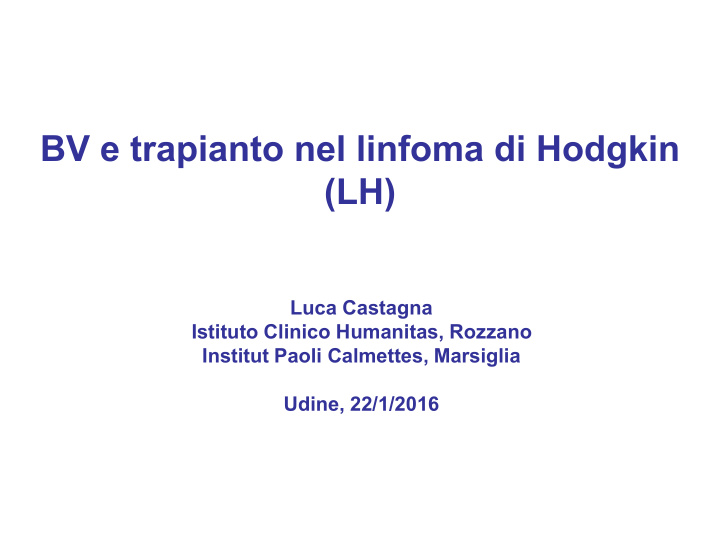



BV e trapianto nel linfoma di Hodgkin (LH) Luca Castagna Istituto Clinico Humanitas, Rozzano Institut Paoli Calmettes, Marsiglia Udine, 22/1/2016
Indicazioni BV 1. In seguito a trapianto autologo di cellule staminali (ASCT) 2. In seguito ad almeno due precedenti regimi terapeutici, quando l’ASCT o la polichemioterapia non è un'opzione terapeutica.
BV e trapianto nel LH • BV for patients relapsed after AUTO or refractory to CT • BV as consolidation treatment after AUTO • BV as treatment of relapse after ALLO
Brentuximab Vedotin • SGN-35 is an ADC containing the antimitotic drug monomethylauristatin E (MMAE) linked to the anti-CD30 monoclonal antibody, cAC10 • Limited expression on normal tissues – Activated T cells and B cells; T cells from aGVHD – Some activated monocytes and eosinophils • High level expression in tumors – HL , ALCL – Embryonal carcinoma
Mechanism of Action • Efficient intracellular release of MMAE, with intracellular concentrations of MMAE in the range of 500 nmol/L – MMAE has a half-life of retention of 15 to 20 h • Co-cultures of CD30+ and CD30− cell lines indicate a bystander activity – MMAE released from CD30+ cells is able to kill CD30− cells
BV for patients relapsed after AUTO 1 or refractory to CT
%
Results
Female, Younger Relapsed 10/102 ECOG Limited disease
BV in relapsed/refractory patients Younes Rothe Zinzani Gibb 2012 2012 2013 2013 N 102 45 65 18 Relapse after HDC 100% 87% 92% 33% ORR 75% 60% 29/70% 72% CR 34% 22% 21% 17% PR 41% 38% 8% 55% DOR all responding 6.7M 8M 6,8M 5M DOR CR 20 M 13M ( CR+PR ) / / ALLO (elegible/done) 102/6 39/0 62/9 18/4 OS 73%@3y 83%@1y 74%@20M / PFS 58%@3y 43%@1y 23%@20M 20%@1y Response max 3 cycles / 3 cycles 4 cycles
Chen, BBMT 2015
BV in relapsed/refractory after HDC: ICH experience N 18 Stage I/II 2 (12%) III/IV 16 (88%) B symptoms 4 (22%) Bulky 2 (12%) Extra-nodal 13 (72%) Disease at BV Refractory 14 (78%) Relapsed 3 (17%) UK 1 Best response to BV 14 (78%) CR 2 After 2-4 cycles PR 12 Final response to BV CR/PR 3/5 (44%) PD 10 (56%) Therapy post-BV ALLO 9 (50%) CT/Nivolumab 2/3 (28%) No therapy 4 (22%)
BV as consolidation treatment after 2 AUTO
BV as consolidation Inclusion criteria PFS • Failure to achieve CR • CR < 12M • Extranodal involvement Response evaluation • CT scan Primary end-point • PFS
BV as consolidation OS
BV as treatment of relapse after 3 ALLO
ALLO RIC N Disease status Relapse rate PFS OS TRM Robinson 2002 52 CT S 67% 45%@2y 42%@2y 56%@2y 17%@2y Peggs 2005 49 CT S 67% 33 %@4y 39%@4y 55%@4y 15%@2y Alvarez 2006 40 CT S 50% / 32%@2y 48%@2y 25%@1y Todisco 2006 14 CT S 57% / 25%@2y 57%@2y 0 Corradini 2007 32 CT S 62% 81%@3y / 32%@3y 3%@3y Anderlini 2008 58 CT S 52% 61%@2y 20%@2y 48%@2y 15%@2y Devetten 2009 143 CT S 44% 47%@2y 20%@2y 37%@2y 33%@2y Robinson 2009 285 CT S 59% 53%@3y 29%@4y 25%@4y 19%@1y Sureda 2012 92 CT S 67% 59%@4y 24%@4y 43%@4y 15%@1y
BV and relapse after ALLO N Relapse rate Med time to relapse (months) Corradini 2007 32 81%@3y 6 (1-42) CR/PR 11 Refractory 4 Anderlini 2008 58 61%@2y 4 (2-13) Sureda 2008 89 57%@3y 6 (1-50) Burroughs 2008 38 id 56%@2y 4 (0-88) 24 UD 63%@2y 9 (0-28) 38 aplo 40%@2y 6 (0-36) Robinson 2009 285 53%@3y 6 (1-59) Sureda 2012 92 59%@4y 6 (3-35) Castagna 2012 unp 53 31%@1y 4 (1-13)
BV and relapse after ALLO Gopal Carlo-Stella 2012 2015 N 25 16 ORR 75% 68% CR 34% 31% PR 41% 37% DOR all responding 6.7M 5M DOR CR 20 M 11M OS 73%@3y 61%@2y PFS 58%@3y 20%@2y
BV and relapse after ALLO Median time from ALLO to SGN35: 42 months (6-116) Median time from ALLO to SGN35: 30 months (9-87) Gopal, Blood 2012
Brentuximab post ALLO Gopal, Blood 2012
Brentuximab post ALLO • 4 patients have been treated • All pts showed a metabolic response • Demonstrating an immunological effect on HL cell lines, by a heterogenous lymphocytes population, CD161+ CD4+ cells ,corresponding to Th17 T cells. Theurich, JCO 2012
Quali scenari ALLO-SGN35 Condizionamento Brentuximab singolo agente • Profilassi Brentuximab + DLI • Pre-emptive Brentuximab + DLI + CT • Recidiva/progressione
Quali scenari ALLO-SGN35 Condizionamento Brentuximab singolo agente • Warning – Associazione SGN35 con alcuni farmaci può associarsi a complicanze (bleomicina, gemcitabina) – Associazione “proibita” con busulfano?
Quali scenari ALLO-SGN35 • Profilassi Brentuximab + DLI • Pre-emptive Brentuximab + CT + DLI • Recidiva/progressione (Gopal 2012) • Profilassi : tutti pazienti sono trattati perché il rischio di recidiva è elevato in generale. Ma non tutti recidivano. – Esistono pazienti particolarmente a rischio elevato? • Pre-emptive : si basa su una metodica che permette di individuare precocemente la recidiva. – PET post-allo?
Quali scenari ALLO-SGN35 • In profilassi o pre-emptive – Brentuximab singolo farmaco o in associazione? – Tossicità eccessiva – Aumento del rischio di complicanze immunologiche • Brentuximab +/- CT + DLI è probabilmente la scelta più idonea • Inizio < 6 mesi
Quali scenari ALLO-SGN35 • La sequenza Brentuximab +/- CT + DLI è probabilmente la più idonea Brentuximab +/- CT DLI Zitvogel, Nat Rev 2011
Grazie per l’attenzione!
Recommend
More recommend